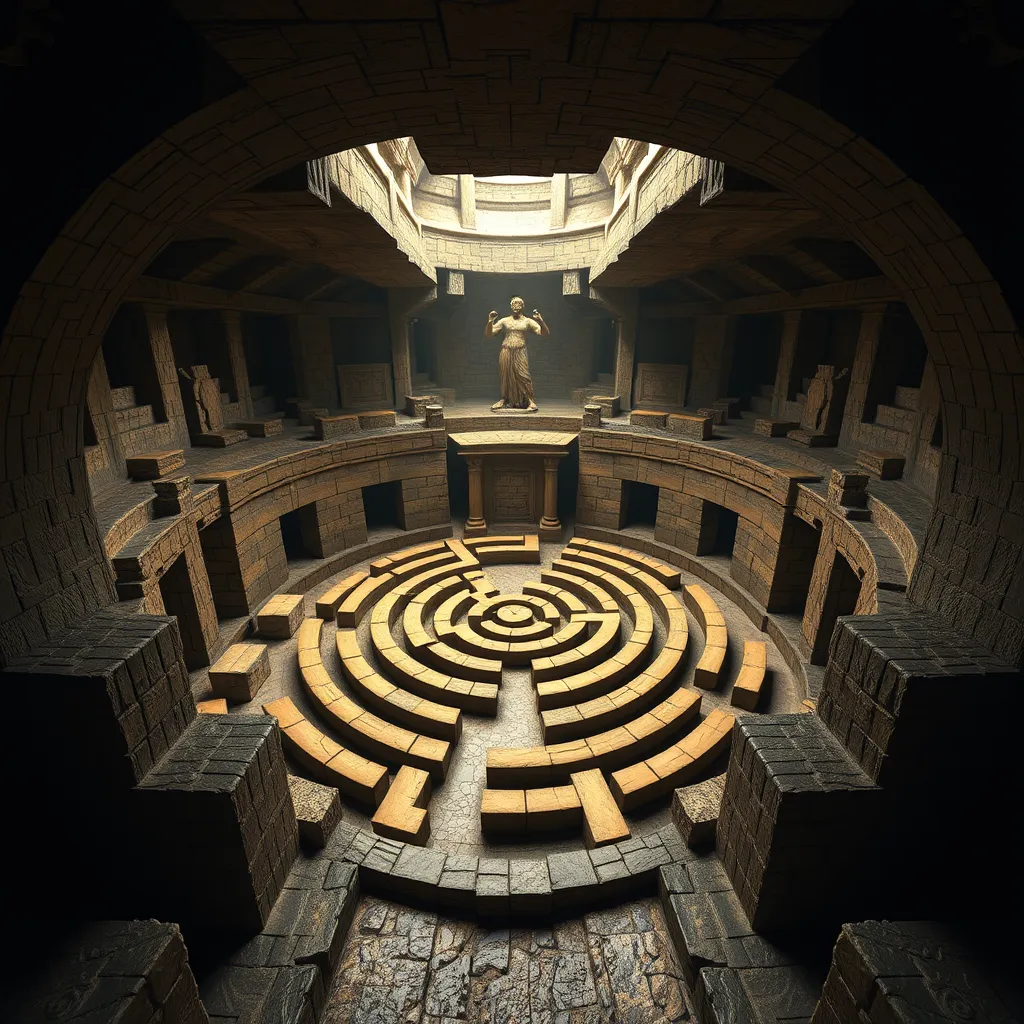The Labyrinth’s Architecture: Exploring the Symbolism of the Maze in the Minotaur Myth
I. Introduction
The myth of the Minotaur is one of the most compelling stories from ancient Greek mythology, intertwining themes of heroism, tragedy, and the complexities of human nature. At the heart of this myth lies the Labyrinth, a formidable maze designed to contain the fearsome Minotaur, a creature that is half-man and half-bull. The Labyrinth not only serves as a prison for the beast but also symbolizes the intricate paths of life and the challenges one must navigate.
This article aims to explore the multifaceted symbolism of the maze within the Minotaur myth, examining its historical context, architectural features, and the deeper meanings associated with its structure and design.
II. Historical Context of the Labyrinth
A. Origins of the Labyrinth in Minoan Crete
The concept of the Labyrinth traces its origins to Minoan Crete, where archaeological evidence suggests the existence of complex architectural designs that could be likened to mazes. The term “Labyrinth” is believed to be derived from the Minoan word “labrys,” which refers to a double-headed axe, a symbol associated with the Minoan civilization.
B. Architectural features of ancient labyrinths
Ancient labyrinths were characterized by their intricate layouts, designed to confuse and disorient those who entered. Some notable features include:
- Winding paths and dead ends
- Multiple entrances and exits
- Varied wall heights and materials
These architectural elements combined to create a sense of disorientation, making the Labyrinth not just a physical structure, but an embodiment of psychological challenges.
C. Influence of the Labyrinth on later cultures and myths
The influence of the Labyrinth extends beyond the Minoan civilization, impacting various cultures and myths throughout history. From the Roman poet Ovid to the modern interpretations in literature and film, the symbolism of the Labyrinth has remained relevant, representing the complexities of the human experience.
III. The Design and Structure of the Labyrinth
A. Description of the Labyrinth’s layout
The Labyrinth in the Minotaur myth is often depicted as a vast maze with a convoluted layout. It is said to have been constructed by the architect Daedalus, who designed it to be so complex that anyone who entered would struggle to find their way out.
B. Symbolic significance of its complexity
The complexity of the Labyrinth serves as a metaphor for life’s challenges. Just as Theseus navigates the winding paths to confront the Minotaur, individuals must navigate the complexities of their own lives, facing fears and uncertainties along the way.
C. The role of architecture in creating an immersive experience
The architectural design of the Labyrinth plays a crucial role in immersing individuals in a space that reflects their inner turmoil. The physicality of the walls and the twists and turns symbolize the unpredictable nature of life’s journey.
IV. The Labyrinth as a Symbol of Journey and Transformation
A. The hero’s journey in mythology
The Labyrinth is often intertwined with the archetype of the hero’s journey, a common motif in mythology. In the case of Theseus, entering the Labyrinth signifies the beginning of his transformation from a youth into a hero.
B. The concept of the maze as a path to self-discovery
Beyond physical challenges, the maze represents a path to self-discovery. Navigating the Labyrinth forces individuals to confront their fears, desires, and inner conflicts, ultimately leading to personal growth.
C. Comparisons to other cultural labyrinths and their meanings
Labyrinths appear in various cultures, each with its own interpretations and meanings. Some notable examples include:
- The Chartres Cathedral labyrinth in France, symbolizing spiritual pilgrimage
- The Native American maze, representing the journey of life and the quest for knowledge
- Modern labyrinths in therapy, used for meditation and personal reflection
These examples highlight the universal appeal of the labyrinth as a symbol of journey and transformation.
V. The Minotaur as a Representation of Inner Conflict
A. The Minotaur’s symbolism in relation to human nature
The Minotaur itself is a powerful symbol of the darker aspects of human nature—our primal instincts, fears, and the chaos within. As a creature born of unnatural union, it represents the consequences of unchecked desires.
B. The relationship between the hero and the beast
The dynamic between Theseus and the Minotaur reflects the struggle between order and chaos. By confronting the beast, Theseus confronts not only the physical embodiment of fear but also the inner demons that challenge his identity and agency.
C. The Labyrinth as a metaphor for confronting one’s demons
The Labyrinth serves as a metaphorical space where individuals must confront their own demons. Just as Theseus faces the Minotaur, we all must confront the aspects of ourselves that we fear or reject, leading to personal transformation and growth.
VI. The Role of Ariadne in Navigating the Labyrinth
A. Ariadne’s thread as a symbol of guidance and hope
Ariadne, the daughter of King Minos, provides Theseus with a thread to help him navigate the Labyrinth. This thread symbolizes guidance, hope, and the importance of connection in overcoming life’s challenges.
B. The importance of collaboration in overcoming challenges
Ariadne’s role emphasizes that collaboration is essential in overcoming obstacles. The journey through the Labyrinth is not solely an individual endeavor; support from others can illuminate our paths and provide strength.
C. Feminine power and agency within the myth
Ariadne’s agency in the myth challenges traditional gender roles. She plays a crucial role in the hero’s success, highlighting the significance of feminine power and the necessity of recognizing the contributions of all individuals in the journey of life.
VII. Modern Interpretations of the Labyrinth Symbolism
A. The Labyrinth in contemporary literature and art
In contemporary literature and art, the Labyrinth continues to serve as a rich symbol. Authors and artists explore themes of identity, transformation, and the complexities of existence through labyrinthine structures.
B. Psychological interpretations of the maze
Psychologically, the Labyrinth can represent the mind’s complexities. Therapists may use labyrinths as tools for introspection, encouraging individuals to navigate their thoughts and emotions in a structured yet challenging environment.
C. The Labyrinth as a metaphor in modern society
In modern society, the Labyrinth serves as a metaphor for the overwhelming nature of contemporary life. With information overload and the complexities of relationships, individuals often find themselves navigating their own mazes, seeking clarity and direction.
VIII. Conclusion
In conclusion, the Labyrinth in the Minotaur myth is a profound symbol rich with meaning. It represents not only the physical challenges faced by the hero but also the psychological and emotional journeys that define the human experience. The enduring legacy of the Labyrinth in culture and psychology speaks to its universal significance as a metaphor for navigating life’s complexities. As we confront our own mazes, the lessons of the Minotaur myth remind us of the importance of courage, guidance, and the transformative power of self-discovery.



